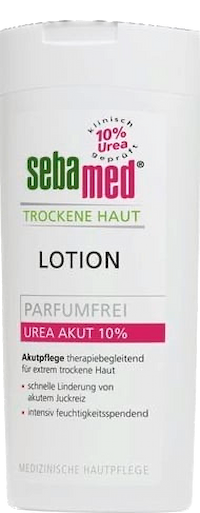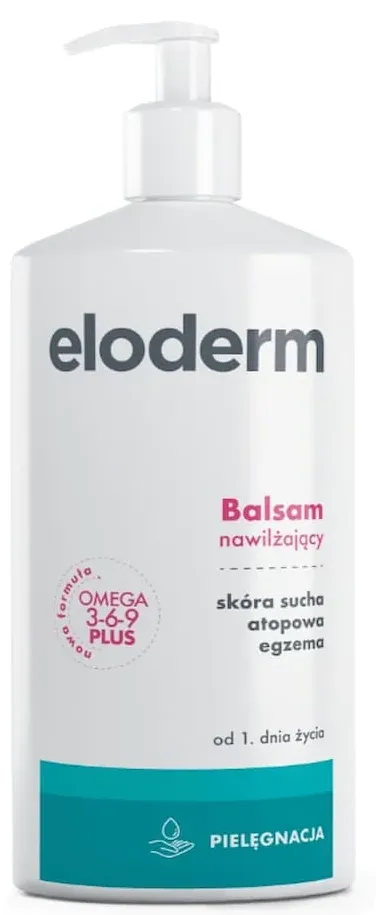Stretch marks on breasts, thighs, abdomen: what they are and where they come from
Find out everything you need to know to successfully get rid of stretch marks.
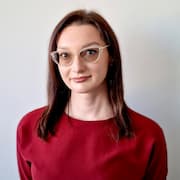

Learn more about our editorial process
.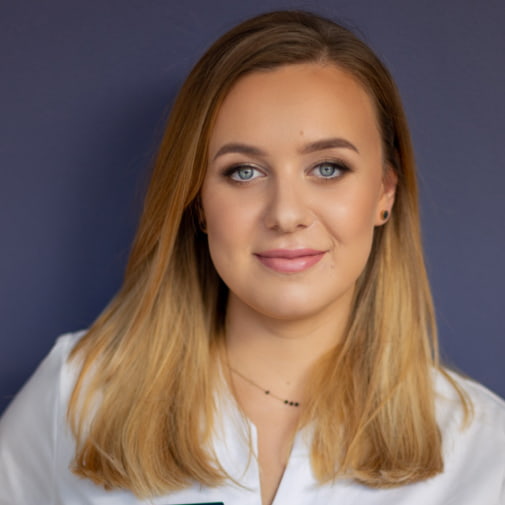

Learn more about our editorial process
.

Learn more about our editorial process
.

Learn more about our editorial process
.
Why you can trust us
Articles on Natu.Care are written based on scientific research, data from government websites and other reliable sources. The texts are written in cooperation with doctors, nutritionists and other health and beauty experts. Articles are reviewed before publication and during significant updates.
.Learn more about our editorial process
.Information about advertisements
Content on Natu.Care may contain links to products from the sale of which we may receive a commission. When creating content, we adhere to high editorial standards and take care to be objective about the products discussed. The presence of affiliate links is not dictated by our partners, and we select the products we review ourselves completely independently.
.Learn more about our terms and Conditions
.Most women (and quite a few men) have them. For many, they are a source of complexes and contribute to lower self-esteem. Stretch marks are one of the biggest challenges in the fight for flawless skin.
Stretch marks are completely normal and common lesions that appear on the skin. Some of us have had them since early adolescence, others developed them after pregnancy. Whatever the reason for their appearance, they are not very welcome. Fortunately, they can be prevented.
.
From this article you will learn:
- What stretch marks are and how they form.
- What they are.
- What contributes to their formation on the skin. .
- How to reduce the appearance of stretch marks. .
- How to effectively prevent these changes. .

Sprawdź, za co pokochały go tysiące klientek Kolagen Premium (5000 mg) mango-marakuja -15% z kodem BLOG15
Natu.Care Kolagen Premium 5000 mg, mango-marakuja
Natu.Care Kolagen Premium dla zdrowia stawów, skóry, paznokci i włosów. Najlepsza przyswajalność. Optymalna dawka 5 000 lub 10 000 mg. Przebadany przez niezależne laboratorium.
Zobacz więcej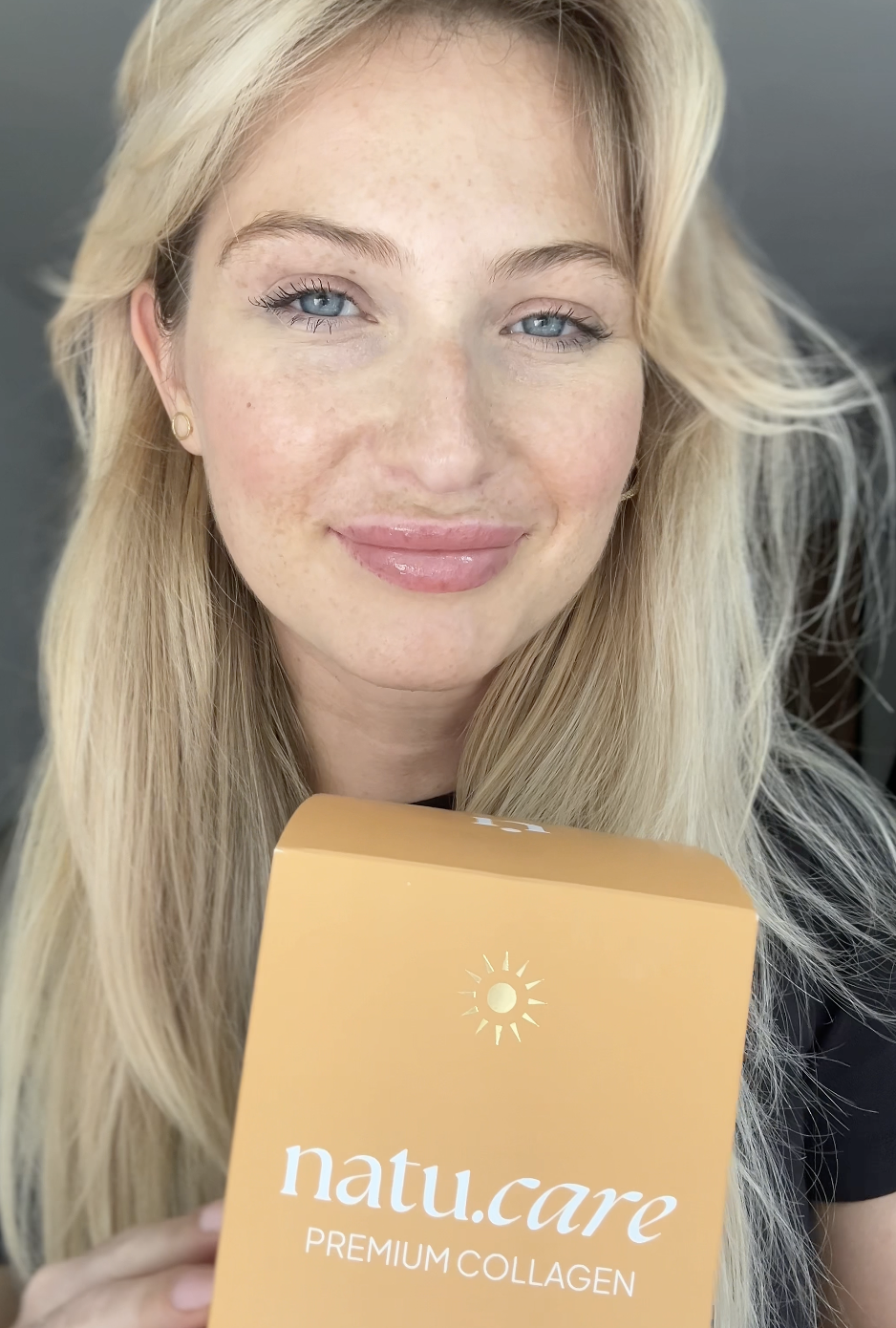
Wybrałam kolagen Natu.Care, ponieważ miał super opinie – a to było dla mnie bardzo ważne! Odkąd go stosuję, moja skóra znacznie się poprawiła i jest nawilżona, a na głowie pojawiły się nowe "baby hair".@Kasia S.
See also:
.
What are stretch marks?
.
Your skin is made up primarily of collagen fibres and elastin. These form a structure resembling a dense mesh and provide the skin with its properties: elasticity and strength.
However, when the skin stretches too quickly, the body may not be able to keep up with the production of these fibres. As a result, striations begin to appear on the skin that resemble scars in appearance - this is what stretch marksand.
.
Stretch marks are skin lesions that resemble scars in appearance, resulting from the weakening of collagen and elastin fibre structures as a result of it stretching too quickly. Their characteristic feature is that they are always parallel to the surface of the skin.
.
These lesions usually appear in specific areas of the body. The most common areand:
- stretch marks on the breasts, .
- stretch marks on thighs, .
- stretch marks on the abdomen, .
- stretch marks on buttocks, .
- stretch marks on hips, .
- stretch marks on back, .
- stretch marks on shoulders (biceps), .
Sometimes it also happens that stretch marks even appear on the face.
Stretch marks on the face.
From what do stretch marks form?
.
Stretch marks can occur whenever the skin has to rapidly increase its surface area in a short period of time. And although the first thing that comes to mind is gaining weight, it is pregnant women and... teenagers who are most commonly affected by stretch marks.
Interesting fact
.According to research, stretch marks are more likely to appear in smokers. No wonder, after all, cigarettes are one of the factors contributing to faster collagen loss the bodyand. Another reason to quit...
.Stretch marks after pregnancy
.
The abdomen in pregnant women begins to enlarge during the second trimester of pregnancy. In less than six months, its circumference will increase by around 30 cm. That's a lot of extra surface area for the mother-to-be's skin to cover. It is estimated that stretch marks will appear in around 43%-88% of pregnant womenand.
Additionally, the circumference of the hips also increases during pregnancy, as fat begins to accumulate on the hips due to hormonal changes. This is another area prone to the occurrence of these skin changes.
Breasts also enlarge during pregnancy and later also during lactation. Their growth is particularly rapid at a time when the body begins to produce breastmilk intensively. The nipples are another area particularly susceptible to the appearance of stretch marks.
Stretch marks.
Stretch marks after the gym
.
You know who else stretch marks? Bodybuilders. As a result of increasing muscle mass, the skin can also stretch. And although physical activity promotes the synthesis of collagen, people who exercise can also develop stretch marks.
Most often, the skin lesions appear in the area of the muscles that grow the fastest. They can affect the biceps, shoulder girdle or thighs. Sometimes they also appear on the backand.
.
Stretch marks at puberty
.
Surely you heard as a child that at some point you shot up. Well that's right, your skin remembers that moment too. Stretch marks can also appear when girls' breasts and hips start to enlarge as a result of puberty - a fairly typical phenomenon. Researchers estimate that stretch marks can affect between 6% and up to 86% of people during pubertyand.
Stretch marks after weight gain
.
Fast weight gain can also end in stretch marks. Fat tissue accumulates quickly and takes up a lot of space under the skin. Frequent fluctuations in weight, whereby the skin loses its elasticity, can be just as dangerous. Stretch marks resulting from weight gain often appear on the abdomen, hips, thighs and buttocksand.
.
Interestingly, stretch marks can also appear as a result of rapid and significant weight loss. This is then associated with a decrease in skin tone .
.
Interesting fact
.Stretch marks can also occur as a side effect of taking certain medications, such as corticosteroidsand.
.Stretch marks can also develop in the course of disease, such as in Cushing's syndrome - very wide, colour-changed and difficult to remove. In the case of sick people, we always work surgically if possible (depending on the disease) in remission and with the doctor's approval..
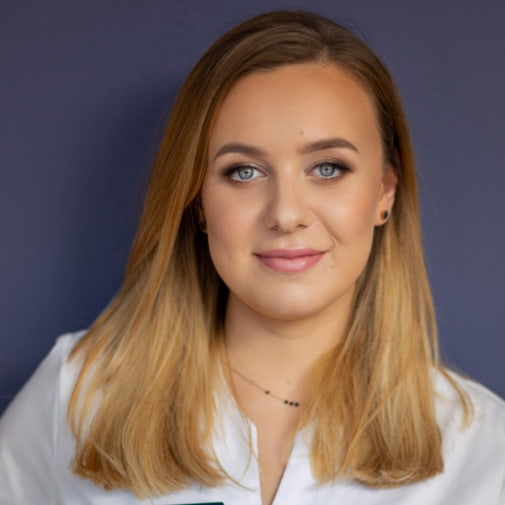 .
.
Katarzyna SrebrCosmetologist
.
How do fresh stretch marks look like?
The initial phase of stretch marks resembles reddish or slightly blue spider veins. It indicates damage to the connective tissue structure in the skinand. Fresh stretch marks can be itchy and even slightly burning. It is at this stage that they are easiest to get rid of.
Stretch marks: red, purple, white...
.
Red or purple stretch marks are a sign of damaged and broken collagen and elastin fibres. They also indicate that inflammation is taking place at the site of damageand.
At the site of a tear in collagen and elastin fibres, the body produces replacement tissue - scar tissue. This is what fills in the spaces of the stretch marks, which were previously red or purple. Because scar tissue lacks the appendages typically found in skin (e.g. melanocytes), healed stretch marks are almost white in colourand.
Can stretch marks disappear?
.
Unfortunately, stretch marks are permanent skin changes that will not disappear on their own. Exactly like scars. Plus, the longer you have them, the harder it will be to get rid of them. The fight against stretch marks is best started when they are in their early stages, that is, when their colour is reddish-purpleand.
How to get rid of stretch marks
.
Stretch marks are difficult to remove, but you can minimise their appearance. To get rid of fresh imperfections, you can try creams and ointments designed for this purpose. Look out for those with natural acids, oils, extracts and active ingredients such as mother of pearl. For older stretch marks, try treatments such as mesotherapy, micropuncture, carboxytherapy or micro-needle radiofrequencyand.
.
Cosmetics for stretch marks
.
In shops and pharmacies you will find many lotions, creams and ointments for stretch marks. Manufacturers often promise to "rebuild collagen and elastin fibres" or "remodel the inner layers of the skin". This is unlikely to happen.
Cosmetics only reach the epidermis and are unable to work on the deeper layers of connective tissue, especially if the stretch marks have already filled in with scar tissue.
If your stretch marks are still fresh, it is worth trying products dedicated to reducing their visibility. Such preparations will mainly have a softening or slightly exfoliating effect. In this way, the lesions can become smaller and shallower, and more similar in appearance to the rest of the skin.
Sebamed, body lotion with urea (10%)
Product description
Regenerating lotion contains 10% urea, whichós renowned for its regenerating properties. The addition of lecithin, sweet almondós and tróiglycerides helps to maintain the skinós lipid balance.
Pros and cons
Regenerating lotion contains 10% urea, whichós renowned for its regenerating properties. The addition of lecithin, sweet almondós and tróiglycerides helps to maintain the skinós lipid balance.
Additional information
Regenerating lotion contains 10% urea, whichós renowned for its regenerating properties. The addition of lecithin, sweet almondós and tróiglycerides helps to maintain the skinós lipid balance.
User review
Regenerating lotion contains 10% urea, whichós renowned for its regenerating properties. The addition of lecithin, sweet almondós and tróiglycerides helps to maintain the skinós lipid balance.
Product description
Valuable omega 3-6-9 complex prevents water loss and increases skin hydrationóry. Tocopherols, or vitamin E, and phytosterols soothe irritation and have an anti-inflammatory effect. This lotion is a treasure trove of active substances with an emollient effect, i.e. they maintain the skinós correct level of hydration, lubrication and elasticity.
Pros and cons
Valuable omega 3-6-9 complex prevents water loss and increases skin hydrationóry. Tocopherols, or vitamin E, and phytosterols soothe irritation and have an anti-inflammatory effect. This lotion is a treasure trove of active substances with an emollient effect, i.e. they maintain the skinós correct level of hydration, lubrication and elasticity.
Additional information
Valuable omega 3-6-9 complex prevents water loss and increases skin hydrationóry. Tocopherols, or vitamin E, and phytosterols soothe irritation and have an anti-inflammatory effect. This lotion is a treasure trove of active substances with an emollient effect, i.e. they maintain the skinós correct level of hydration, lubrication and elasticity.
Expert opinion
Valuable omega 3-6-9 complex prevents water loss and increases skin hydrationóry. Tocopherols, or vitamin E, and phytosterols soothe irritation and have an anti-inflammatory effect. This lotion is a treasure trove of active substances with an emollient effect, i.e. they maintain the skinós correct level of hydration, lubrication and elasticity.
Creams, lotions and ointments will instead be your best ally in preventing stretch marks. They will increase the skin's hydration and elasticity, nourish and strengthen it.
Dry body brushing
.
Dry body brushing helps exfoliate dead skin, stimulates microcirculation and lymph flow. This makes the skin soft, smooth and firm. By exfoliating, brushing can help you reduce the appearance of stretch marks, especially if they are raised. However, by using only brushing, you will not eradicate them completely. But it can be a technique used as an aid.
The brush - as well as cosmetics - will instead help you to reduce the risk of further stretch marks appearing. If you tend to develop these skin lesions, be sure to take an interest in body brushingand.
Massage for stretch marks
.
Massage firms the skin, improves micro-circulation and can help break down and make stiff tissue more elastic. The scar tissue that forms stretch marks is stiffer than the skin. Massage will therefore help to give your stretch marks elasticity and can therefore reduce their appearance somewhat. For better results, combine it with oils or creams for stretch marksand.
See also:
.
Collagen for stretch marks
.
The most effective form of administration collagen for stretch marks is that intradermal. Most commonly, collagen preparations are used as injections or as an adjunct to treatments carried out in cosmetic surgeries. They are administered, for example, with needle or micro-needle mesotherapyand.
Collagen in supplement form can also help you fight stretch marks. It will provide your body with the necessary building blocks to restore damaged skin structuresand. However, just drinking collagen -without additional skin stimulation-may not be enough.
Natu.Care Collagen Premium 5000 mg, mango & passion fruit
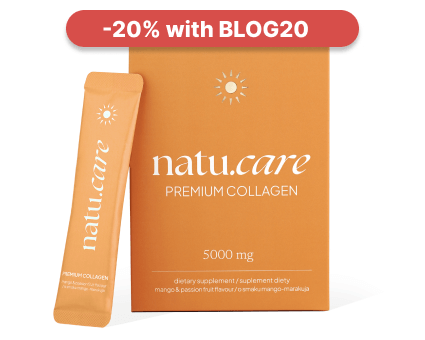
- Collagen content: 5000 mg marine collagen hydrolysate
- Additional active ingredients: vitamin C, low molecular weight hyaluronic acid (and L-theanine and coenzyme Q10 in cocoa flavoured collagen or vitamin A and vitamin E in mango–passion fruit flavoured collagen)
- Form: powder sachets
- Dose: 1 sachet per day
- Sufficient for: 30 days
Product description
Fish collagen from the Natu.Care brand in a dose of 5000 mg, based on certified ingredients of the best quality. Regular supplementation will positively influence the appearance of the skinóry, hairów and nails – they will be rebuilt and strengthened from the inside.
In addition to collagen, which is valuable for health and beauty, it also offers other active ingredients that help to maintain a youthful complexion, shiny hair and strong nails.
The formula contains a sufficient portion of the active ingredient to positively affect joints, the musculoskeletal system and immunity.
Natu.Care Premium Collagen is available in two flavours – Cacao Bloom and Rise&Shine. Both formulas are based on the following active ingredients: marine collagen hydrolysate, wild roseóbud extract and hyaluronic acid.
Additionally, Cacao Bloom contains natural L-theanine, coenzyme Q10 and defatted Dutch cacao. Rise&Shine instead contains vitamin E and vitamin A.
These are the best collagens in the world.
These best fish collagens on the market also rós taste – Cacao Bloom is a treat for chocolate lovers. Rise&Shine will appeal to those whoólike the refreshing taste of mangoófruit and passion fruit.
Pros and cons
Pros:
- Vitamin C supports the body's collagen production, enhancing its effectiveness.
- An effective dose of hyaluronic acid, which additionally supports skin hydration and joint health.
- Fish collagen absorbs 50% better. Additionally, the manufacturer specifies the fish species it is sourced from (Atlantic cod).
- The composition has been tested by the independent and accredited J.S. Hamilton laboratory.
- MSC (Marine Stewardship Council) quality certification, which confirms that the collagen source supports sustainable fishing practices.
Cons:
- None.
Additional information
Natu.Care's fish collagen receives praise for its delicious taste. You won't find the fishy aftertaste that often comes through in other collagens. Plus, you have two tasty flavors to choose from: cocoa and mango-passionfruit.
Active ingredients like coenzyme Q10, hyaluronic acid, and natural L-theanine provide anti-inflammatory and antioxidant benefits while slowing down aging processes.
User review
Super, after about 6 weeks of use, the skin on my face became noticeably firmer. Wonderful taste.
Ania ZalewskaNatu.Care customer
.
Stretch mark treatments
.
Unquestionably, cosmetology gives the most noticeable results for stretch marks and even those you have been struggling with for many years. Unfortunately, the cost of such treatments is considerable - you usually have to pay several hundred zlotys for a single office visit. And in the case of scars and stretch marks, a single session is usually not enough. Treatments need to be repeated several times to achieve optimal results.
.
The most popular and effective treatments for stretch marks are:
. .
It is the most recent treatment in South American medicine.
|
Treatment . |
Action . |
Number of repetitions needed to achieve an effect . |
|
| . |
Laser |
A light beam of the appropriate length damages the skin in a controlled manner. This stimulates the regenerative processes and the remodelling of the connective tissue. |
Approximately 6 treatments. |
|
Needle mesotherapy . |
It consists of a series of injections of a therapeutic preparation into the areas where stretch marks are present.
|
Needle mesotherapy is a treatment for stretch marks. |
Approximately 4-5 treatments. |
|
Microneedle mesotherapy . |
I.e. the popular dermapen. First, a nourishing ampoule is applied to the surface of the skin. Then, using a special device equipped with fine needles, the specialist makes many micro-punctures in the skin. This fulfils two roles: firstly, it helps the ampoule to penetrate deep into the skin; secondly, the micro-punctures also stimulate the skin remodelling processes and the formation of new collagen and elastin fibres. |
Approximately 4-5 treatments. |
. |
|
Carboxytherapy . |
It consists of injecting medical carbon dioxide into the altered tissues. An inflammation is created at the injection site, which stimulates skin regeneration and the formation of new collagen and elastin structures. Carbon dioxide also causes the blood vessels to dilate and better oxygenate and nourish the skin. |
Multiple treatments. |
. |
|
Micro-needle radiofrequency . |
Combines pricking the skin with micro-needles and heating it with radiofrequency waves. This causes two types of damage to the skin: mechanical and thermal. As a result, the body is doubly stimulated to regenerate and triggers repair processes with even greater power. Thereby, the body is doubly stimulated to regenerate and triggers repair processes with even greater power. |
About 3 treatments. . |
|
|
Micropuncture . |
This is a recent treatment, taken from South American medicine. It involves using various puncture techniques to stimulate the skin's remodelling processes. At the end of the treatment, a special gel is applied to the surface of the skin to further stimulate the regenerative processes. |
One treatment and, if necessary, treatments to maintain the effect every 6 months. |
. |
How to prevent stretch marks?
.
It is well known that prevention is better than cure. With stretch marks, this principle applies particularly well. If you are at a time when your skin may be particularly prone to stretch mark formation, it is best to apply some stretch mark prevention techniques in advance.
The most effective combination is a combination of:
- brushing the body dry, .
- applying moisturising and skin-elastating lotions, creams or oils, .
- massaging sensitive areas (abdomen, thighs, hips, buttocks or shoulders), massaging the skin.
- maintain a healthy and nutritious diet and additional collagen supplementation (especially if you are more than 25 years old).
Remember, however, that these methods will only be effective if you use them regularly, over an extended period of time.
See also:
.
Summary
.
- Stretch marks are permanent skin lesions involving the disruption of collagen and elastin fibres.
- Stretch marks are permanent skin lesions involving the disruption of collagen and elastin fibres.
- Stretch marks are formed when the skin has to stretch considerably in a short period of time.
- Stretch marks are the result of a stretch mark.
- Fresh stretch marks are red or purple in colour, older ones become almost white. .
- The most effective way to reduce the visibility of stretch marks is through treatments carried out by a cosmetologist. .
- You can try to combat stretch marks with cosmetics, body brushing, massage and collagen supplementation. These methods will also help you to prevent the formation of these lesions.
FAQ
.How do stretch marks form?
.Stretch marks are formed when the skin has to enlarge its surface area in a short period of time. With such stretching, the structures of collagen and elastin in the connective tissue can be disrupted. The area is then filled with scar tissue and characteristic striations on the skin occur.
What for red stretch marks?
.Red stretch marks are those in the early stages of formation. They are also accompanied by a slight inflammation. To reduce their appearance, try cosmetics dedicated to stretch mark removal, such as creams, lotions, ointments and oils. You can also opt for treatments carried out by a cosmetologist - for example, those using injections with collagen.
How to eradicate stretch marks.
Unfortunately, stretch marks cannot be eradicated 100%, but you can significantly reduce their appearance. The most effective are cosmetic treatments performed by specialists, such as micropuncture, mesotherapy, lasers or carboxytherapy. For fresh stretch marks, you can also try cosmetics skin softening, massages or dry body brushing.
What do stretch marks look like?
.Stretch marks are characteristic striations that are always arranged parallel to the surface of the skin. At first, stretch marks are red or purpleish "patterns" resembling zebra stripes. Later they become almost white.
.Will mesotherapy work on stretch marks?
.Yes, mesotherapy - both needle and micro-needle - is one of the most effective treatments that can help you reduce the appearance of stretch marks. These treatments work on the deeper layers of tissue to initiate the skin's natural repair processes and stimulate the production of collagen.
Can stretch marks be done in children?
.Yes, stretch marks can also form in children and are associated with rapid accelerated growth. They are also common in girls during their teenage years when, under the influence of puberty, fatty tissue starts to accumulate in the breasts and on the hips.
Do stretch marks hurt?
.In the initial phase, when stretch marks are still red or slightly blue, they may be accompanied by an itching and burning sensation. Older lesions are painless and harmless - they only affect the visual effect.
.
Resources
.See all
.Abbas, A. M., Kamel, F. M., & Salman, S. A. (2019). Clinical significance and treatment of striae gravidarum during pregnancy: A review article. International Journal of Reproduction, Contraception, Obstetrics and Gynecology, 8(1), Article 1. https://doi.org/10.18203/2320-1770.ijrcog20185454
Dai, H., Liu, Y., Zhu, Y., Yu, Y., & Meng, L. (2021). Study on the methodology of striae gravidarum severity evaluation. BioMedical Engineering OnLine, 20(1), 109. https://doi.org/10.1186/s12938-021-00945-w
Deflorin, C., Hohenauer, E., Stoop, R., van Daele, U., Clijsen, R., & Taeymans, J. (2020). Physical Management of Scar Tissue: A Systematic Review and Meta-Analysis. The Journal of Alternative and Complementary Medicine, 26(10), 854-865. https://doi.org/10.1089/acm.2020.0109
Huang, Q., Xu, L., Wu, T., & Mu, Y.-Z. (2022). New Progress in Therapeutic Modalities of Striae Distensae. Clinical, Cosmetic and Investigational Dermatology, 15, 2101-2115. https://doi.org/10.2147/CCID.S379904
Medline ® Abstract for Reference 79 of 'Striae distensae (stretch marks)'-UpToDate. (n.d.). Retrieved 13 September 2023, from https://www.uptodate.com/contents/striae-distensae-stretch-marks/abstract/79
Mendes, N., Alves, P. J., Barros, M., Rodrigues, J. M., & Machado, J. (2022). A Narrative Review of Current Striae Treatments. Healthcare, 10(12), Article 12. https://doi.org/10.3390/healthcare10122565
Oakley, A. M., & Patel, B. C. (2023). Stretch Marks. In StatPearls. StatPearls Publishing. http://www.ncbi.nlm.nih.gov/books/NBK436005/
.Pieraggi, M. Th., Julian, M., Delmas, M., & Bouissou, H. (1982). Striae: Morphological aspects of connective tissue. Virchows Archiv A, 396(3), 279-289. https://doi.org/10.1007/BF00431387
Scar Tissue-An overview | ScienceDirect Topics. (n.d.). Retrieved September 13, 2023, from https://www.sciencedirect.com/topics/medicine-and-dentistry/scar-tissue
Shen, Y., Pang, Q., & Xu, J. (2022). Comprehensive pathogenesis and clinical therapy in striae distensae: An overview and current perspective. Chinese Journal of Plastic and Reconstructive Surgery, 4(4), 203-207. https://doi.org/10.1016/j.cjprs.2022.10.002
van der Sluijs, E., Slot, D., Hennequin-Hoenderdos, N., & van der Weijden, G. (2018). Dry brushing: Does it improve plaque removal? A secondary analysis. International Journal of Dental Hygiene, 16(4), 519-526. https://doi.org/10.1111/idh.12358
Wollina, U., & Goldman, A. (2017). Management of stretch marks (with a focus on striae rubrae). Journal of Cutaneous and Aesthetic Surgery, 10(3), 124-129. https://doi.org/10.4103/JCAS.JCAS_118_17
.
Editorials
Meet the team

Cosmetologist
Cosmetologist and linergist with extensive experience working with clients with a wide range of skin health needs and concerns.

![Dry skin on the face: causes, creams [how to moisturise the face].](https://cdn-resources.natu.care/uploads/1/krem_do_twarzy_hero_5b78656ee8.jpg)
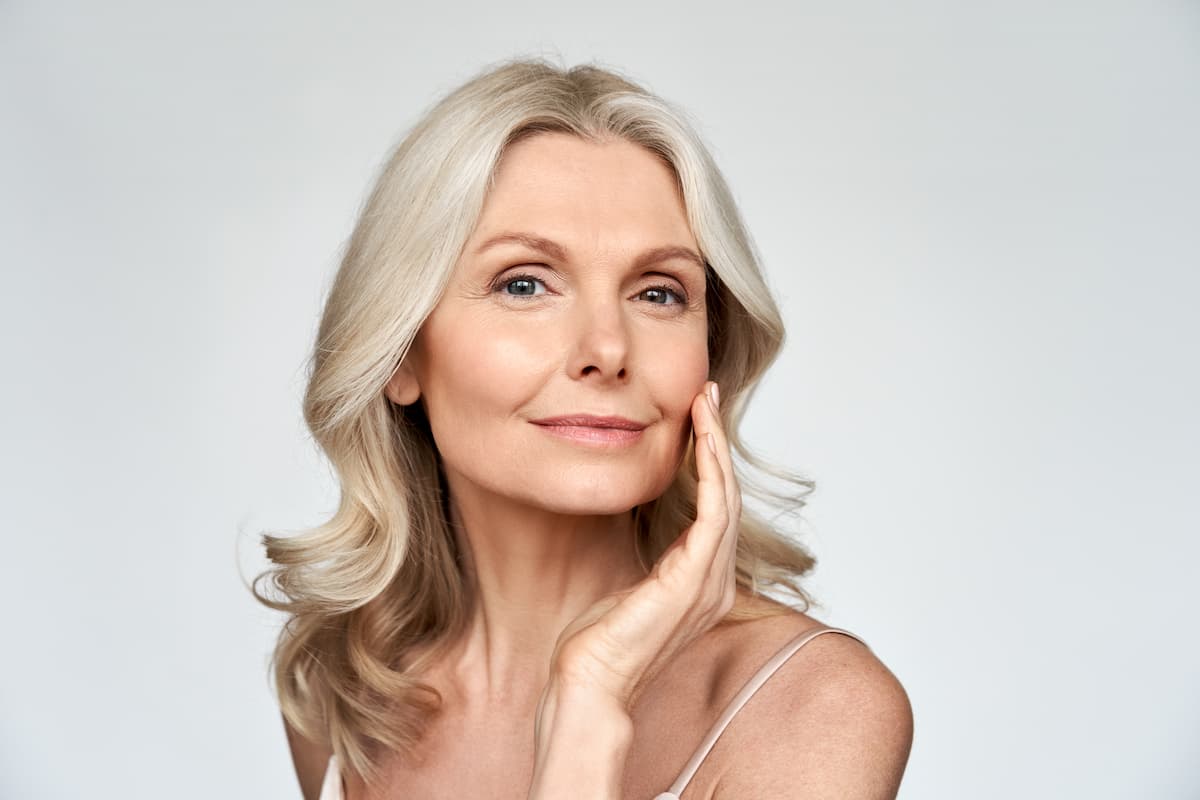
See how to stop the passing of time. That is, the best ways to get rid of wrinkles.
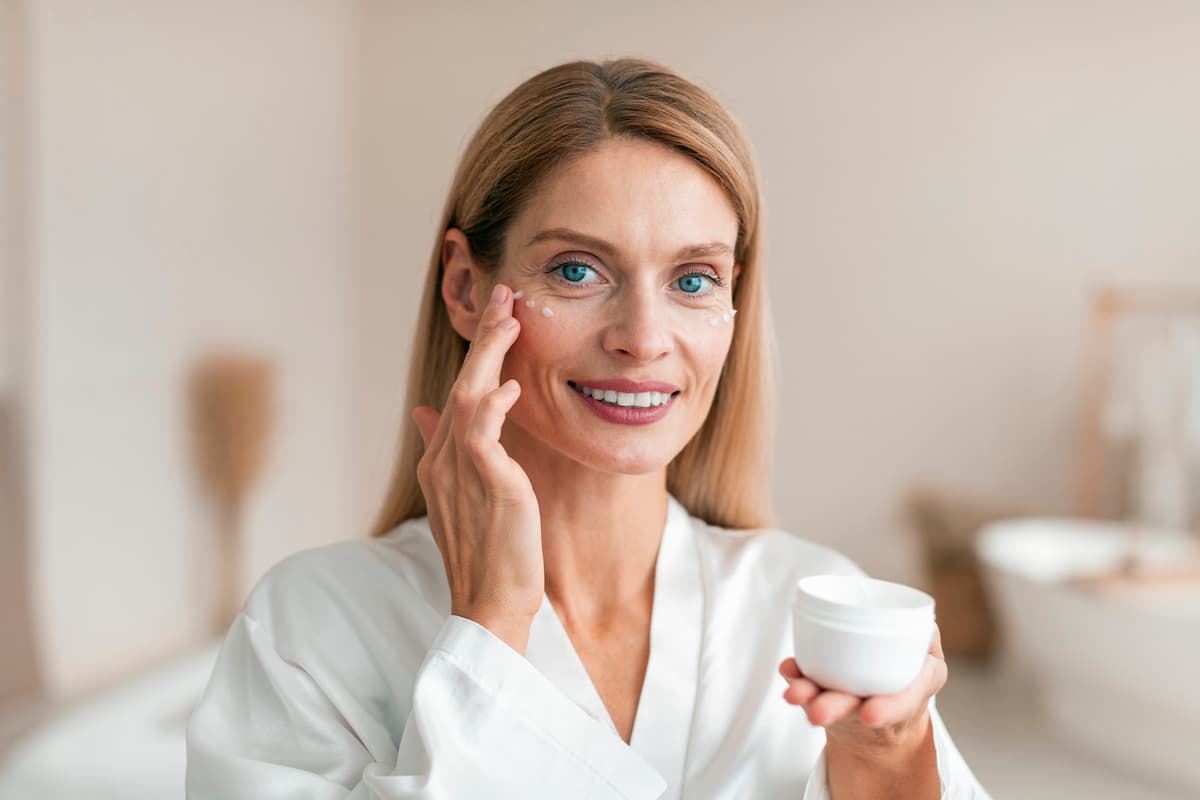
Read about effective methods to combat wrinkles around the eyes.
